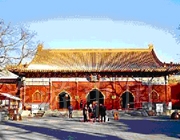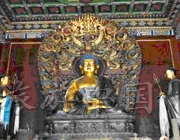Lama Temple
It also named Yonghe Palace. Located at the northeastern corner of Beijing City, Yonghe Lamasery, originally built in 1694 in Chinas Qing Dynasty (1644 - 1911) is reputed to be the largest Tibetan Buddhist temple in the city.
Yonghe Lamasery, originally built in 1694 in Chinas Qing Dynasty (1644 - 1911) is reputed to be the largest Tibetan Buddhist temple in the city.
Covering an area of 66,400 square meters, this temple is listed as significant historical site protected by the national government.
The whole architecture features a blending of Han, Manchu, Mongolian and Tibetan Buddhist styles and over the entrance gate of each main hall hangs a plaque with the name of the hall with inscriptions in Tibetan, Mongolian and Chinese languages. In 1725, the site was turned into a royal residence and changed to yellow, which is the royal color.
The Lama  Temple preserves over one thousand Buddhist figures and rich classical cultural relics of Buddhism. Besides, it displays a large number of other rare cultural relics, including its three treasures: a 18-metre-high statue of Maitreya (the Smiling Buddha) carved out of a single sandalwood trunk; the miniature "Mountain of Five Hundred arhats" made of gold, silver, copper, iron and tin; and a shrine made of Nanmu, a precious hardwood with golden veins.
Temple preserves over one thousand Buddhist figures and rich classical cultural relics of Buddhism. Besides, it displays a large number of other rare cultural relics, including its three treasures: a 18-metre-high statue of Maitreya (the Smiling Buddha) carved out of a single sandalwood trunk; the miniature "Mountain of Five Hundred arhats" made of gold, silver, copper, iron and tin; and a shrine made of Nanmu, a precious hardwood with golden veins.
In the Hall of the Boundless Happiness, stands a famous huge statue of Buddha, 26 meters high carved out of a whole piece of sandalwood; it is the biggest wood-carving Buddha in the world.